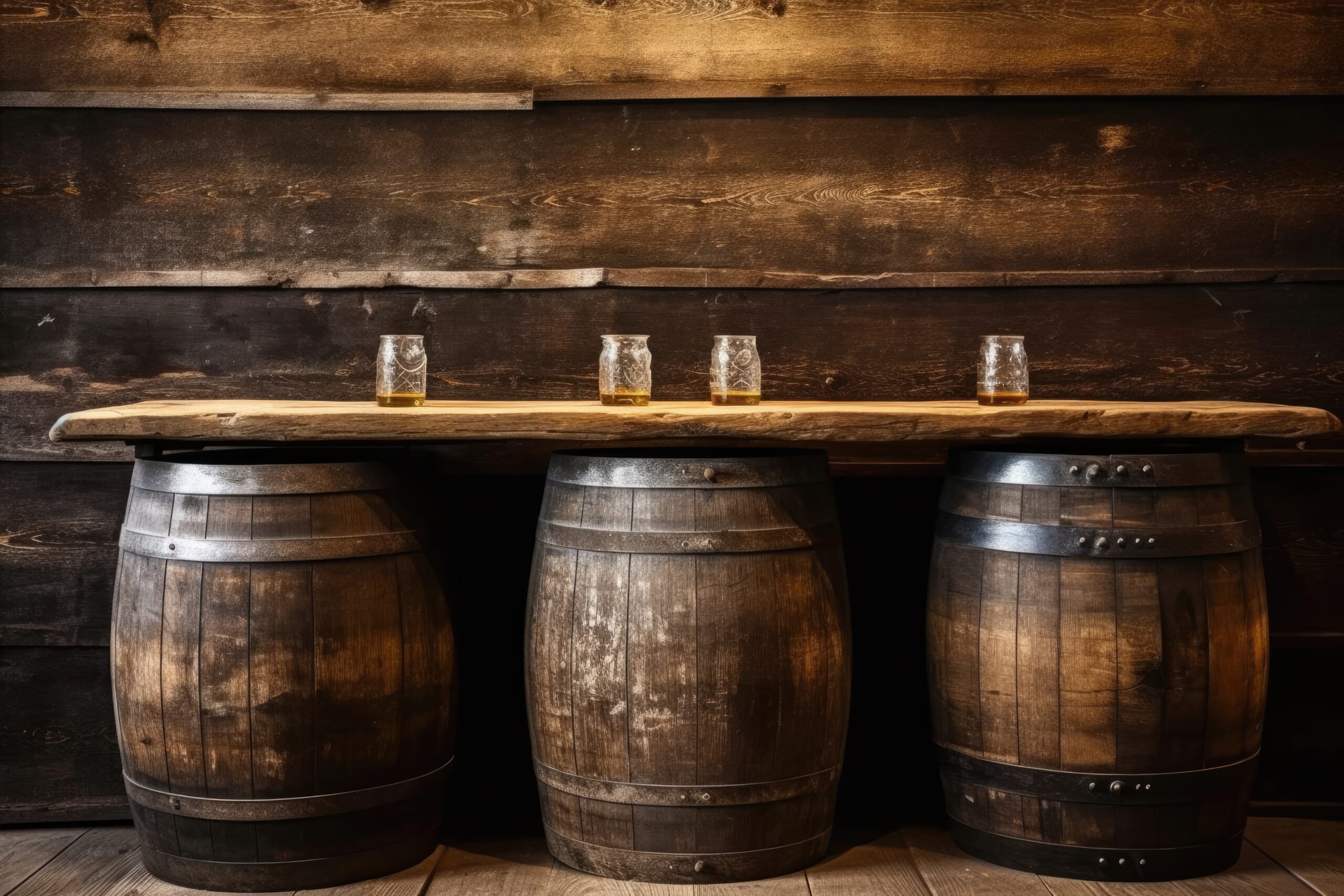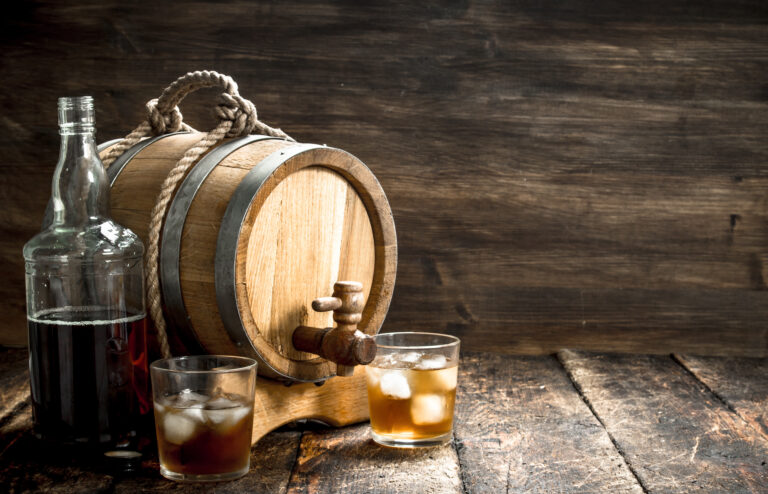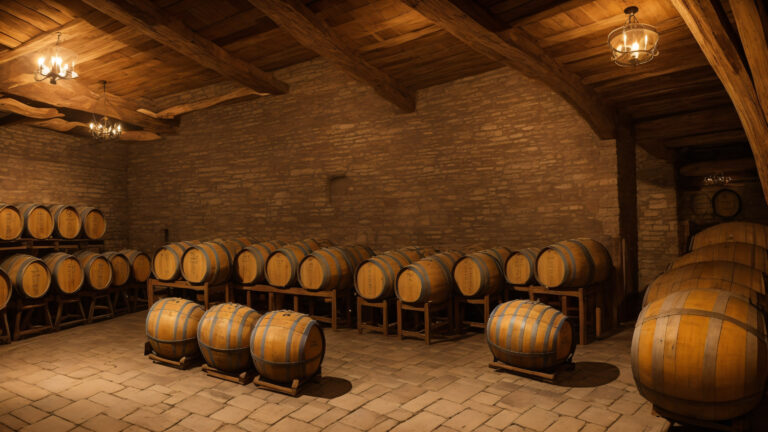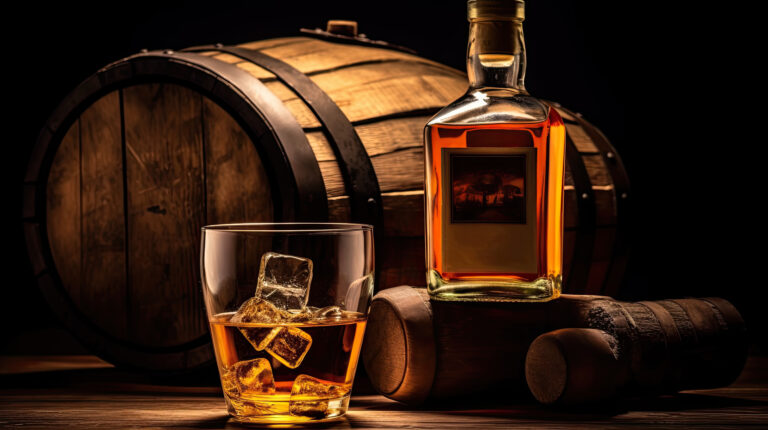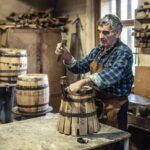Ever wondered why some whiskeys hit you with a smoky punch while others glide down, smooth and mellow? The real magic happens in the barrel! Barrel aging is the secret sauce that gives whiskey its unmistakable flavor and gorgeous color.
But for an extra special treat, some distillers pull out a trick called double barrel aging. This is where they first age the whiskey in one barrel, typically charred American oak, then — boom! — it’s off to a second barrel. Often, this second home previously held something like sherry or port wine. This second interaction infuses the whiskey with a whole new world of flavors, creating an even more intricate taste profile.
So, next time you’re savoring a glass of whiskey, take a moment to really appreciate the dedication and artistry poured into perfecting it. Double barrel aging isn’t just a process; it’s truly an art form that unlocks the full spectrum of flavors a whiskey can offer.
What Is Double Barrel Aging?
Double barrel aging is essentially a secret weapon used to amp up the flavor and complexity of whiskey. After its initial snooze in charred oak barrels, the whiskey gets a change of scenery, moving into a second set of barrels. These often come with a history, having previously cradled wine, sherry, or port.
The Process
Think of it like this: the whiskey first soaks up classic flavors and aromas from its primary barrel, usually made from American white oak. Then, it’s transferred to the second barrel. Here, it continues to absorb even more flavors from the wood itself, plus any lingering whispers from its former contents. The grand finale? A whiskey with layers of nuanced flavors that go way beyond your typical oak and vanilla notes.
The type of wood and what was in that second barrel before makes a huge difference to the final flavor. For instance, a bourbon finished in sherry barrels might pick up hints of dried fruit, a lovely nuttiness, and a touch of spice. Whiskey that’s spent time in ex-wine barrels could lend delicate notes of grape or a different kind of oak character.
And it’s not just what was in there, but how long. The more time the whiskey chills in that second barrel, the stronger those extra flavors become. A few months might introduce subtle shifts, but several years can truly transform the spirit.
The Benefits
Double barrel aging is a meticulous dance of skill and patience. But when it’s done right, the payoff is huge:
- Added Complexity: The mingling of flavors from two different barrels creates a truly complex taste with delightful, layered notes.
- Balance: This process can really smooth out any rough edges, creating a harmonious blend of oak, fruit, nut, and spice flavors.
- Uniqueness: Every barrel has its own personality. So, even if the process is the same, each batch will have its own subtle, unique characteristics.
- Premium Quality: Because of the extra time, resources, and expertise involved, double barrel aged whiskeys are often seen as a premium product – and priced accordingly.
For both seasoned whiskey connoisseurs and those just starting their journey, double barrel aged whiskeys offer a fantastic way to experience the pure artistry involved in producing a spirit of exceptional quality, depth, and distinction. Trust us, the results are absolutely worth the wait!
The History of Double Barrel Aging
Believe it or not, double barrel aging has been crafting complex, flavorful whiskeys for centuries. The tradition of aging whiskey in charred oak barrels, then giving it a finishing touch in a second barrel, adds those wonderful extra layers of aroma and taste.
This practice actually goes back to the 1700s. As whiskey journeyed long distances, the constant movement and temperature swings during transport really affected its flavor. Distillers found that transferring the whiskey to a fresh charred oak barrel after its long trip actually improved it! They stumbled upon the discovery that this additional aging brought in new flavors from the second barrel’s wood.
In the early 1800s, fortified wines and sherry casks became incredibly popular for this second aging. The wine-soaked wood infused the whiskey with delightful fruity and nutty flavors.
By the mid-1800s, aging in port, Madeira, or rum casks gained traction, adding hints of dried fruit, chocolate, or spice.
Fast forward to the 1900s, and ex-bourbon barrels became widely available and a go-to for the second aging. This extra charred oak aging intensified those lovely vanilla and caramel notes.
Today, master distillers meticulously select barrels to perfectly complement and enhance the original aging process. The beautiful blend of flavors from two different barrel types, new wood, and the double aging itself creates an endlessly complex and refined spirit. And that lingering finish from double barrel aging? It leaves an impression as unforgettable as the taste.
So, next time you take a thoughtful sip of an aged whiskey, consider the long and rich history and the incredible craft behind its double barrel aging. Just like a fine wine, whiskey truly achieves an elevated richness of flavor through the alchemy of time, wood, and sheer patience.
How Double Barrel Aging Works
Double barrel aging is a technique that’s all about adding extra flavor and complexity to whiskeys. Distillers move the whiskey from its original barrel to a new one, usually made of charred oak. As the spirit soaks up flavors from the wood, you get those delightful notes of vanilla, caramel, and spice.
The Practice of Double Barrel Aging
To get that double barrel aged whiskey, distillers first age the spirit in charred oak barrels for several years. Then, they carefully drain the whiskey from these first barrels and transfer it to a second set of fresh charred oak barrels. The whiskey then gets to sit for an additional aging period, allowing it to pull even more flavors from the wood.
The type of wood and the level of char in that second barrel significantly impact the final flavor. Distillers might use barrels that previously held port, sherry, rum, or wine to impart specific tastes. More heavily charred barrels will generally lead to darker, smokier whiskeys.
Interestingly, the whiskey interacts with the wood differently in the second barrel. Compounds in the spirit that were used up during the first aging are replenished, sparking new flavor combinations. The additional oxidation and evaporation in the second barrel also play a role in tweaking the flavor profile.
The ultimate result of double barrel aging is a whiskey with more pronounced wood notes like vanilla, nuts, and spice. It also creates a remarkably smoother, mellower spirit, thanks to that extra mellowing from the wood. The end game is a whiskey with incredible depth, complexity, and a wonderful oakiness.
The Rise in Popularity of Double Barrel Aged Whiskeys
In recent years, double barrel aging has really exploded in popularity. Distillers are constantly experimenting with different techniques to craft unique, premium whiskeys. Many brands now proudly offer double barrel variants, and some, like Maker’s Mark, have practically built their reputation on this very process. For whiskey aficionados, those extra layers of flavor from double barrel aging are absolutely worth the higher price tags. This practice of finishing whiskey in a second set of casks truly adds another dimension of artistry to the already skilled craft of distilling.
The Types of Barrels Used for Double Barrel Aging
Double barrel aging whiskey is all about allowing those extra complex flavors to develop. Distillers will move the whiskey from its original barrel to a second, often different, barrel to continue its maturation journey. This interaction with two different barrels gives the whiskey deeper, richer notes.
Charred Oak Barrels
The most common barrel you’ll find is charred American oak, typically bourbon barrels. The charring process caramelizes the wood, infusing a distinctive vanilla and smoky flavor. Bourbon barrels also lend subtle spice notes. For double barrel aging, the whiskey might even be transferred to a second bourbon barrel to intensify these existing flavors.
Non-Charred Oak Barrels
Some distillers opt for non-charred oak barrels, like French oak. French oak tends to bring out more delicate fruit notes such as apple, pear, and citrus. This clean, crisp oak can pair beautifully with whiskey that has already undergone initial aging in charred barrels.
Other Barrel Types
This is where distillers really get creative with the second barrel! Port, sherry, rum, and wine barrels are popular choices. They infuse the whiskey with delightful notes of berries, nuts, and sometimes even chocolate. The port and sherry barrels, in particular, are fantastic at creating a whiskey with layers of both dried and fresh fruit.
Blending Barrels
Instead of moving the entire batch to a single new barrel, some distillers prefer to blend multiple barrel types. A portion might go into charred oak, another to port barrels, and still another to sherry casks. After additional aging, these components are then masterfully blended together. This creates an incredibly intricate whiskey with a true spectrum of flavors in every single sip.
Double barrel aging is undeniably an art form. Master distillers meticulously select barrels that will perfectly complement and build upon the original aging. With the right blend of barrels and precise aging time, a double barreled whiskey can truly become a complex and flavorful pour like no other. But remember, good things come to those who wait – the best whiskeys are always worth the patience.
The Impact on Flavor and Aroma
Double barrel aging means letting the whiskey mature in two distinct types of barrels, usually starting with charred new oak barrels and then moving to used barrels that previously held sherry, port, or wine. This two-step process profoundly shapes the flavor and aroma of the final whiskey.
New Oak Barrels
When whiskey is first distilled and aged in fresh charred oak barrels, it absorbs classic flavors of vanilla, caramel, and spice from the wood. The char on the inside of the barrel also contributes a subtle smoky essence. At this initial stage, the whiskey can be a bit harsh and lacking in complexity.
Used Barrels
Transferring the whiskey to used sherry, port, or wine casks introduces a fantastic array of fruity and nutty notes. The whiskey mingles beautifully with the residual wine flavors trapped in the wood, mellowing its character and adding fantastic layers of aroma and taste. Common descriptions for double barreled whiskeys often include dried fruit, nut, chocolate, and even tobacco.
The longer a whiskey rests in those used barrels, the more influential the wine characteristics become. Master distillers carefully monitor the whiskey to pinpoint the ideal time to bottle, ensuring a harmonious blend of flavors. Too long, and the whiskey might lose its unique qualities, becoming overly wine-like. Too soon, and the full impact of those used barrels won’t be realized.
Best of Both Worlds
Double barrel aging is a true art form that brilliantly combines the best elements of both barrel types. The comforting warmth and spice of new charred oak is perfectly balanced by the exotic notes brought in by port or sherry. The end result? A whiskey with unparalleled depth, aroma, and finish – truly a journey in every single sip.
For whiskey connoisseurs, double barreled varieties represent the pinnacle of the distiller’s craft. If you’re looking to experience whiskey at its absolute finest, treat yourself to a vintage that’s been aged to perfection in not one, but two distinguished barrels. Your taste buds will definitely thank you!
Popular Whiskeys That Use Double Barrel Aging
Double barrel aging is a go-to process for creating wonderfully complex, flavorful whiskeys. Distillers typically age the whiskey in charred oak barrels, then move it to a second set of barrels—often older and more porous—for further maturation. This additional aging in different barrels results in whiskeys with truly distinctive tastes and aromas.
Maker’s Mark Bourbon
Maker’s Mark is aged in charred white oak barrels for at least four years before it gets its finishing touch in barrels with a #4 char, which is a medium char. This double barrel aging process leads to delightful notes of caramel, vanilla, and spice in the bourbon.
Woodford Reserve Double Oaked
Woodford Reserve ages its bourbon in charred barrels for a minimum of four years. Then, it’s finished in a second, heavily toasted barrel for an extra nine months. This double barrel aging creates a bourbon bursting with notes of caramel, chocolate, cinnamon, and nutmeg.
Elijah Craig Small Batch
Elijah Craig Small Batch ages for 8-12 years in charred oak barrels. It’s then transferred to barrels that previously held port or sherry wines for 3-6 months. This port and sherry barrel finishing adds lovely fruity flavors of dark cherries, currants, and figs to its rich oak character.
Jack Daniel’s Single Barrel Select
Jack Daniel’s Single Barrel Select matures in charred oak barrels for 4-7 years. It’s then aged in barrels located in the upper levels of the warehouse, where temperature variations lead to increased interaction between the whiskey and the wood. This “double barrel aging” (in essence, maximizing wood interaction in a specific warehouse environment) results in a whiskey with robust oak, caramel, and spice flavors, alongside subtle notes of smoke, leather, and toasted nuts.
Whiskeys that utilize double barrel aging are highly prized for their complexity, depth of flavor, and balance. The combination of aging in multiple barrels, often with different levels of char or prior uses, allows distillers to craft premium whiskeys with truly distinct taste profiles. For whiskey aficionados, double barrel aged options offer an exciting array of flavors just waiting to be explored.
The Pros and Cons of Double Barrel Aging
While double barrel aging whiskey can unlock incredibly complex flavors, it’s not without its trade-offs.
Enhanced Flavor
Aging whiskey in two different barrels—typically a new charred oak barrel followed by a used one—exposes the spirit to a much wider range of wood compounds that impart distinctive flavors. The new barrel contributes those classic vanilla, caramel, and oak notes. The second barrel, often a used bourbon or sherry cask, adds another fascinating layer of flavor from its previous contents, like dried fruit, nutty, or spicy notes. The ultimate result is a whiskey with significantly enhanced depth, richness, and complexity.
Higher Cost
Let’s be real, double barreling requires purchasing and managing two sets of barrels, more warehouse space, and longer aging periods. This significantly drives up production costs, which, unsurprisingly, often gets passed on to you, the consumer, through higher bottle prices. For smaller craft distilleries with tight profit margins, that additional investment might not make economic sense.
Less Control
While a master distiller has considerable control over the first maturation phase, the second barreling introduces more variables. The previous contents of those used casks and how long they were aged can affect the final flavor profile in unexpected ways. There’s definitely an element of experimentation and even a bit of chance involved that could lead to an undesirable result.
Diluted Flavor
When whiskey is moved to a second barrel, a portion is usually lost to evaporation (the “angel’s share”) and absorption into the wood. What’s left is a smaller volume of whiskey that needs to last through the entire second aging period. So, even though more complex notes develop, the whiskey can sometimes lose some of the concentrated, robust flavors it picked up during its initial aging.
Double barrel aging is truly as much an art as it is a science. When executed well, it can elevate a good whiskey into a truly great one. However, the added costs, potential loss of control, and possibility of diluted flavors mean it might not be the right fit for every distiller or every single expression. As with many things, moderation and balance are absolutely key.
Other Aging Techniques Compared to Double Barrel
Other aging techniques are popular for crafting unique flavor profiles, but for maximizing sheer complexity, double barrel aging truly stands out.
Single Barrel Aging
This is the standard approach: whiskey is aged in a single charred oak barrel. It’s simple but effective, as the whiskey absorbs classic flavors from the wood like vanilla, spice, and caramel. However, single barrel aging typically produces more fundamental flavors.
Small Barrel Aging
This method uses smaller barrels, ranging from 5 to 30 gallons. The increased surface area to volume ratio means the whiskey ages faster. While this can yield good results in less time, it often lacks the intricate depth you find in double barrel aging.
Solera Aging
With Solera aging, whiskey is matured in a series of barrels and then blended together, with a portion bottled at each stage. The barrels are then refilled with new whiskey. This technique provides fantastic consistency but tends to result in less distinctive flavors.
Finishing
Here, whiskey is first aged in a standard barrel, then transferred to a second barrel that previously held wine, sherry, or port. While this absolutely adds lovely fruity and nutty notes, it can sometimes overwhelm the original whiskey’s flavor.
Double barrel aging cleverly combines the best aspects of multiple techniques. The whiskey gets its initial aging in a charred barrel for a solid foundation, and then it’s aged in a second, used barrel. This second aging, whether in a barrel that previously held bourbon, sherry, or another spirit, imparts complementary flavors without overpowering the whiskey’s original character.
This multi-step process results in an unparalleled medley of tastes – those familiar oak and smoke notes are beautifully balanced with exotic spice or dried fruit. Simply put, no other method develops such a symphony of flavors or as much aroma, body, and character. A double barrel aged whiskey is truly greater than the sum of its parts.
The Future of Double Barrel Aging in Whiskey Production
The practice of double barrel aging whiskey is definitely on the rise! Distillers are constantly pushing boundaries, experimenting with different types of barrels, aging periods, and blending techniques to create truly unique flavors.
Types of Barrels
Beyond the traditional charred oak barrels, distillers are getting creative, aging whiskey in barrels that previously held sherry, port, rum, and various wines. Each unique barrel imparts its own distinct flavor profile to the whiskey. For instance, aging in sherry casks often brings out dried fruit, nuts, and spice. Port barrels can yield notes of berry, raisin, and even chocolate. And rum barrels might introduce delightful tropical fruit and molasses notes.
Aging and Blending
Some distillers meticulously age the whiskey in one barrel for a specific period, then transfer it to another barrel for further aging. Others are masterfully blending whiskeys from different barrels to create entirely new flavor profiles. The possibilities for experimentation truly feel endless!
Innovation
Some distilleries are taking double barrel aging to the next level, venturing into triple barrel aging and even beyond! A few are even experimenting with barrels made from different types of wood, such as maple or hickory. This continuous innovation in the world of craft whiskey is sparking an explosion of new and incredibly unique flavors.
The Future
While double barrel aging is still somewhat a niche market, its popularity is surging. As consumers increasingly demand more variety and complex flavors in their whiskeys, double barrel aging and other innovative techniques are likely to become much more mainstream. Distillers will undoubtedly continue to push the envelope, striving to create the most unique and flavorful whiskeys imaginable. The future of double barrel aging looks incredibly promising for both whiskey connoisseurs and innovators alike.
The practice of aging whiskey in a second barrel isn’t just a trend; it’s a genuine art form that allows distillers and blenders to craft whiskeys with incredible layers of flavor. Double barrel aging is definitely here to stay in the world of craft whiskey.
Final Thoughts
So there you have it – a deep dive into the fascinating, intricate process of double barrel aging whiskey. As you’ve discovered, it demands incredible patience, an expert palate, and a willingness to truly experiment. The results, however, speak for themselves.
Next time you raise a glass of your favorite aged whiskey, take a moment. Swirl it around, breathe in those incredible aromas, and truly contemplate the remarkable journey it took to get into your glass. All those years resting in charred barrels, slowly absorbing flavors from the wood, gradually mellowing into a smooth, incredibly complex spirit. Double barrel aging might be an art form, but the pure enjoyment of a fine aged whiskey? Now that’s pure science.
